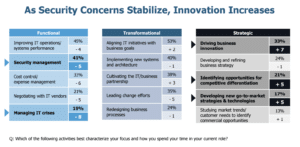
How to Build a Savings Pipeline for SaaS Renewals
Table of Contents ToggleWhat Is a SaaS Savings Pipeline?Why Managing SaaS...
Back
Back
Search for Keywords...
Blog

Table of Contents
CIOs have a mounting challenge of not only discovering the cloud apps that their organization is using, but also managing those apps and SaaS solutions. They each with their own nuances, like renewal dates and terms, which make rightsizing cloud apps ever the more challenging.
But on top of that, “Transformational” CIOs, as defined by the 2017 State of the CIO report, have more and more pressure from the CEO and other executives to innovate within their organizations and cut unnecessary or overlapped spending. Just a few of their strategic initiatives might includes:
But CIOs have to constantly forge the battle of [their teams] gathering and analyzing data and helping line of business owners make technology decisions all while growing their organizations strategically. While CIOs may now have the ability to gain never-before-achieved visibility into their cloud spend and utilization, and they now have the ability to manage 3rd party software relationships, they also need a way to support future growth—not just current.
According to the report, 72% of Heads of IT say that it’s a challenge for the CIO to find the right balance between operations and innovation. This is especially troubling as they are expected to lead product innovation, reduce spending, and enable global expansion, among other important initiatives. None of these important goals, however, can ever be achieved without optimization and scaling cloud stacks.

CIOs must be smart about how their departments, along with line of business owners and employees, are purchasing and using technology—one of the top business line items. Take for example the rapidly-growing mobile company, Yext. In an interview with CFO Steve Cakebread, he shared that 100% of its systems are SaaS rather than traditional on-premise software. Steve and his team strive to get the business to run its technology on approximately 2-3% of revenue, but he would like to see systems cost around 1% of revenue as the business grows.
How is it possible for executives to accomplish those goals quarter after quarter, year after year? Technology savings and optimization must go hand in hand.
It is possible for CIOs to free up time while also right-sizing their cloud stacks with a Cloud Intelligence System of Record that can help them save costs while simultaneously increasing innovation. How is this level of optimization possible?
Spend: With spend information, CIOs can identify and eliminate redundant subscriptions while driving data-driven negotiations for renewals.
Usage: Usage data, such as that which can identify and eliminate underutilized subscriptions, can also help CIOs re-provision underutilized licenses.
Innovation: Finally, CIOs can detect new applications gaining critical mass early on, and use application history to inform new purchases, equaling true innovation.
Rightsizing starts with understanding the ins and outs of SaaS optimization. Take the first toward SaaS transformation at your organization. Learn more in our Practical Guide to Rationalizing, Rightsizing, and Renewing SaaS, or grab your quick-start Rightsizing Checklist to guide you through the process.

Table of Contents ToggleWhat Is a SaaS Savings Pipeline?Why Managing SaaS...

Table of Contents ToggleWhat FinOps Means in the Modern Cloud EnvironmentWhy...

Table of Contents ToggleSavings Opportunities Are CrucialCIOs Need to Right-Size Cloud...

Table of Contents ToggleSavings Opportunities Are CrucialCIOs Need to Right-Size Cloud...
| Cookie | Duration | Description |
|---|---|---|
| cookielawinfo-checkbox-analytics | 11 months | This cookie is set by GDPR Cookie Consent plugin. The cookie is used to store the user consent for the cookies in the category "Analytics". |
| cookielawinfo-checkbox-functional | 11 months | The cookie is set by GDPR cookie consent to record the user consent for the cookies in the category "Functional". |
| cookielawinfo-checkbox-necessary | 11 months | This cookie is set by GDPR Cookie Consent plugin. The cookies is used to store the user consent for the cookies in the category "Necessary". |
| cookielawinfo-checkbox-others | 11 months | This cookie is set by GDPR Cookie Consent plugin. The cookie is used to store the user consent for the cookies in the category "Other. |
| cookielawinfo-checkbox-performance | 11 months | This cookie is set by GDPR Cookie Consent plugin. The cookie is used to store the user consent for the cookies in the category "Performance". |
| viewed_cookie_policy | 11 months | The cookie is set by the GDPR Cookie Consent plugin and is used to store whether or not user has consented to the use of cookies. It does not store any personal data. |
